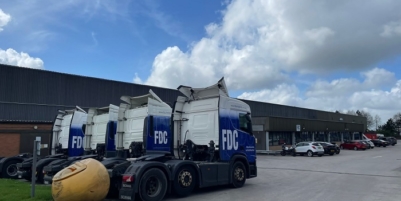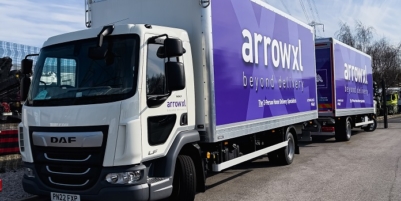-
ROSSLARE EUROPORT TARGETS HEALTH & SAFETY WITH CAMERA TELEMATICS PARTNERSHIP - 2 days ago
-
Landmark Study Reveals Wearable Robotics Significantly Boost Safety and Efficiency in Industrial Environments - July 24, 2024
-
Visku Tackle The Retail Seasonality Challenge One Pallet At A Time - July 22, 2024
-
KAMMAC AND BERGEN LOGISTICS STRENGTHEN FASHION & LIFESTYLE SERVICES IN THE UK - July 19, 2024
-
TENTBOX EXTENDS PARTNERSHIP WITH ARROWXL TO SUPPORT INCREASING DEMAND - July 17, 2024
-
The Perfume Shop improves customer journeys while driving profitability in partnership with Scurri - July 17, 2024
-
ZEROMISSION SECURES £2.3M ($3M) INVESTMENT TO ACCELERATE ELECTRIC FLEETS - July 16, 2024
-
BCMPA CELEBRATES SUCCESS OF 2024 CONFERENCE - July 15, 2024
-
Best of the Best: Jungheinrich Celebrates Triple International Award Win - July 12, 2024
-
GOPLASTICPALLETS.COM CALLS ON NEW CHANCELLOR RACHEL REEVES TO CONSIDER PLASTIC PACKAGING TAX REFORM - July 10, 2024
Online grocery may be booming, but keeping it profitable will be the challenge. Louisa Hosegood, Digital and Strategy Director at Bis Henderson Consulting, believes Micro-fulfilment could be the big game-changer.
The pandemic has advanced consumer engagement with online grocery by between 5 – 10 years, and although online orders still only account for about 10% of the overall mix, the phenomenal growth rates experienced by retailers over the past year are likely to tip the balance on the most widely adopted fulfilment model.

Since it’s strongly believed that over half of the current online behaviour will be maintained after the pandemic ends, retailers are scrambling to come up with faster modes of delivery and more efficient ways to fulfil orders.Delivery timelines for online orders have been shrinking rapidly, ranging from a couple of days to just a few hours, leaving many grocers simply unable to compete with the retail juggernauts for the coveted superfast, premium delivery offers.
A number of grocers have invested heavily in huge automated warehouses, a few are using the strength of partnerships, while most retailers are relying on their existing store footprint to satisfy this massive surge in demand.
In-store grocery fulfilment is by far the most widely adopted approach. It has the huge benefit of being close to the customer, which minimises delivery costs or eliminates those costs if the customer picks up. However, there are drawbacks that have only been exacerbated by the uptake in online order volumes, and now a tipping-point has been reached.
Unrelenting online demand is taking its toll on the in-store customer experience, with online pickers roaming the aisles competing with store customers for products on the shelves and large cumbersome picking trolleys causing congestion. What’s more, retail stores are designed and laid out for browsing shoppers, which is not the most efficient format for order picking. The result is that online fulfilment costs are going through the roof and customer service is being impacted on both channels.A possible solution
However, there is an emerging solution. The concept of micro-fulfilment leverages the advantages of localised delivery, or pick-up, and combines them with the efficiency of a large, automated warehouse. These small-footprint, low investment, highly automated systems – typically occupying 3,000-10,000 sq. ft – can be built into the backroom or on the perimeter of existing stores, or may be deployed as a stand-alone facility to serve a cluster of local geographies.
The idea is starting to level the playing field for businesses competing in online grocery.
The technology makes picking much faster and more accurate, offering the capability to provide online grocery pickup in under an hour from placing an order, while saving on expensive manual labour and distancing picking operations from browsing customers. Most of an order is picked in the automated system and presented to staff for consolidation and delivery, supplemented by an element of manual picking for frozen, deli or loose weighed items.
A key advantage of the automation is that it maximises use of the cube, enabling a wide range of products to be stored densely and retrieved quickly, enhancing product choice, availability and customer service. And locating a Micro-fulfilment Centre (MFC) inside a store benefits from the site being an established replenishment point on the grocer’s main network, so no additional drops are required.
Importantly, MFCs are far less capital-intensive than large warehouses to set up and can be fully functional within just a few months – reducing risk, smoothing investment against volume growth, and providing opportunities to test and learn through modular implementation across a wider grocery network.
Sweating existing assets in this way enables creative property solutions in space-constrained locations, which not only helps to maximise returns on real estate commitments but enables a holy grail of retail to be achieved – proximity to the fast-growing urban eComm-shopping population. Of course, micro-fulfilment is not limited to the grocery sector. The efficiency and cost-effectiveness of deploying such technology makes it appealing to many other eCommerce sectors, from consumer goods to healthcare. However, a standalone MFC run by a 3PL may well be more likely in these instances, where individual retailers share a larger facility with others, and where space can be flexed more easily in response to shifting demand.
Overall, micro-fulfilment has the potential to deliver substantial labour savings, faster order processing, enhanced value from property assets, a strong local connection with the customer and a significantly reduced cost-to-serve, which addresses the all-important profitability challenge.
Bis Henderson Consulting has been working closely with leading grocers in this space, both in the UK and the USA, and are also working with leading property developers in the urban logistics arena. Our comprehensive understanding of the challenges involved in grocery, retail and eCommerce, together with our independent relationships with a wide range of suppliers – from veterans to new entrants – puts us in a strong position to help businesses deploy this potentially game-changing technology. We help define requirements, offer vendor-neutral advice on supplier/solution selection; we collaborate on producing detailed designs, and take the project on through implementation to post go-live review.
Micro-fulfilment addresses some of the greatest challenges facing the online grocery sector. It will just take resolve and expertise to deliver.

































